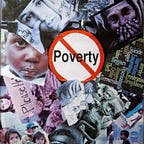How World Conflict Can Affect the Poor.
Violent conflict contributes to poverty in a number of ways, including causing: damage to infrastructure, institutions, and production; the destruction of assets; the breakup of communities and social networks; forced displacement, and increased unemployment and inflation.
Still today most violent conflicts contain religious elements linked up with ethno-national, inter-state, economic, territorial, cultural and other issues. Threatening the meaning of life, conflicts based on religion tend to become dogged, tenacious and brutal types of wars.
At the state level, poverty can lower resilience to conflict by weakening government institutions, stripping capacity for public goods provision, and limiting the projection of power and authority, whether soft or coercive. Poverty also compounds vulnerability to insurgency at the individual and community level by lowering the opportunity cost of mobilizing for violence. High rates of unemployment and inequality, combined with low levels of education and development, are thought to soften the ground for recruitment and provide motives to fight. These individual correlates of poverty often follow systematic patterns that lead to ‘horizontal inequalities. Horizontal inequalities occur when members of ethnic, religious, or other identity groups have unequal access to public goods, opportunities, and resources. Group-level inequalities can generate social and economic polarization that increases the risk of violent conflict.
Once conflict breaks out, it hits the poor the hardest: social welfare is depleted as goods and services are diverted to the war effort; rural infrastructure is destroyed in the contested territory, and justice and security provision retract into urban areas and elite enclaves. Conflict causes and compounds poverty. First depleting labor and human capital, then destroying productive assets and financial capital, and finally, eroding the social capital of trust and cooperation upon which strong political and economic systems depend. The war economies and institutions that are created in conflict are overwhelmingly extractive and tend to warp local political economies through their reliance on smuggling and coercion. These practices can become conflict drivers in their own right and can perpetuate conflict-related violence and inequality even after the war has officially ended.
Our understanding of the effects of conflict over time is still nascent. Evidence from Burundi suggests that households exposed to violence at the local level are more likely to face long-term poverty and deprivation than those who were spared. Exposure to violence also hurts those who participate in armed groups, as they have to overcome an education deficit, social stigma, and psychological distress that can leave them economically alienated and socially marginalized. At the country level, this leads to what some call the ‘conflict trap’. The strongest predictor of civil war onset is whether a country has recently experienced civil war, with harmful ‘neighborhood effects’ making surrounding countries similarly vulnerable to conflict spillover. However, vicious cycles of conflict that exacerbate poverty, slow economic growth, destabilize weak institutions and lead to violent relapse are not inevitable. The international response to post-conflict reconstruction can support a potential ‘phoenix effect’ of strengthened economic growth, where infrastructure development, debt relief and foreign aid, and currency stabilization help to generate private investment. More importantly, local communities have proven remarkably resilient in rebuilding trust, social cohesion and civic engagement after war ends.
An individual’s or household’s ability to respond to economic shocks can determine the impact of conflict on their poverty levels in the short and long term. Further, changes to the social and institutional environment as a result of conflict can affect people’s vulnerability and ability to respond to poverty. The most conflict-affected provinces and districts have the highest levels of poverty within affected countries such as Columbia, Syria, Rwanda, and Uganda. In contrast, the least developed countries struggle most to escape and recover from conflict-related poverty. The long-term country-wide and individual effects of conflict on poverty are not clear. Recovery time from conflict can take upwards of 14 years and often longer. In addition, recovery at the macro level appears to be quicker than at the micro-level.
Resources
The impact of conflict on poverty — GSDRC. (2015, August 3). GSDRC. https://gsdrc.org/publications/the-impact-of-conflict-on-poverty/#:~:text=Violent%20conflict%20contributes%20to%20poverty,and%20increased%20unemployment%20and%20inflation.
Poverty and conflict — GSDRC. (2016, December 16). GSDRC. https://gsdrc.org/professional-dev/poverty-and-conflict/
Horizontal Inequalities, the Political Environment and Civil Conflict: Evidence From 55 Developing Countries — GSDRC. (2015, September 4). GSDRC. https://gsdrc.org/document-library/horizontal-inequalities-the-political-environment-and-civil-conflict-evidence-from-55-developing-countries/
Humphreys, M., & Weinstein, J. M. (2008). Who Fights? The Determinants of Participation in Civil War. American Journal of Political Science, 52(2), 436–455. https://doi.org/10.1111/j.1540-5907.2008.00322.x
Goodhand, J. (2001). Violent Conflict, Poverty and Chronic Poverty. SSRN Electronic Journal. https://doi.org/10.2139/ssrn.1754535
Religion and Conflict — Luc Reychler. (2021). Gmu.edu. https://www.gmu.edu/programs/icar/ijps/vol2_1/Reyschler.htm#:~:text=Still%20today%20most%20violent%20conflicts,and%20brutal%20types%20of%20wars.
